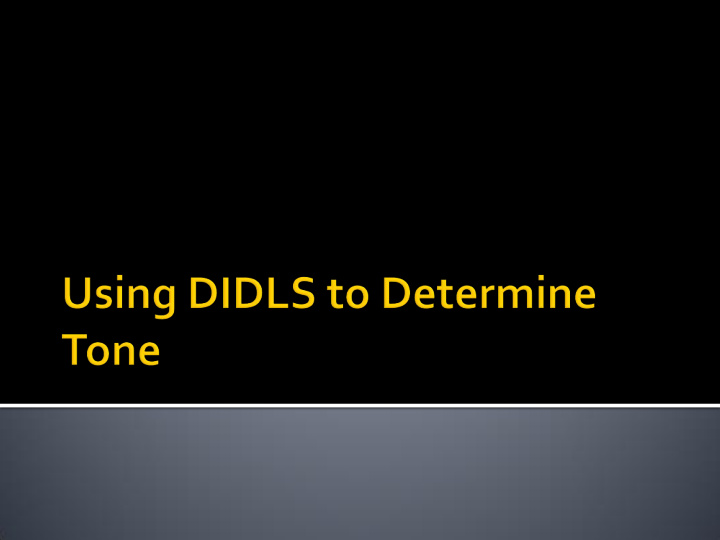



Tone : The writer’s/speaker’s attitude toward his/her subject or audience. This is described by a single adjective (ex. a sarcastic tone, a playful tone, a bitter tone). Tone is important because understanding a writer or speaker’s attitude towards his/her subject enables us to decipher meaning and purpose.
Examine the diction in the passage. 1. Using your knowledge of the diction, 2. determine the possible tone(s) of the passage. Check your tone determinations by 3. examining imagery, detail, and syntax and seeing if they match the tone(s) you have identified.
an acronym that aids you in analyzing a fiction or nonfiction prose passage. D Diction I Imagery D Detail L Language S Syntax
Diction : Word choice Writers choose their words with purpose. If we can analyze diction, it can help us understand their theme and purpose. In order to analyze diction, we have to be able to analyze…
Denotation : The dictionary or literal meaning of a word. Ex : Plump = a full, round, and pleasing figure Connotation : All the meanings, associations, or feelings that a word suggests. Ex : Fat = while similar in denotative meaning to plump, it has a very harsh and mean connotation
Examine the diction in the following sentences. What are the connotations here? Which sentence has a more positive connotation, and which has a more negative connotation? You look unique today. You look odd today. You look weird today.
What are the connotations for each of the following sentences? The student walked into the classroom. The student strutted into the classroom. The student bounced into the classroom.
What are the connotations for each of the following sentences? The old man’s house was the color red. The old man’s house was blood red. The old man’s house was apple colored.
Categorize the following words as having a positive, negative, or neutral connotation. Chuckle Cackle Laugh Self-confident Haughty Proud Old Mature Ancient
Sensory Language : Words Ex: “a thundering downpour of and phrases that appeal to rain” the senses of sight, To what sense(s) does this hearing, touch, smell, example appeal? What and/or taste. Sensory image does it create? details create… Imagery : Vivid descriptions that re-create sensory experiences for the reader, creating “word pictures”
The writer "shows" rather than "tells," thus allowing the reader to participate in the experience more fully. Therefore imagery helps to produce mood and tone. When reading a piece containing imagery, you need to ask yourself two questions. What do I hear, taste, smell, or feel? What effect is the author trying to convey with these messages? Once you have identified a possible tone from the diction, confirm the tone by looking at imagery.
Imagery helps to create… Mood : The feeling or atmosphere that the writer creates for the reader using imagery and setting details. BE VERY CAREFUL NOT TO CONFUSE MOOD AND TONE!! THEY ARE TWO VERY DIFFERENT THINGS!!
Notice that the feeling created is not the creator’s attitude (tone) about the subject of the clip, but rather, an overall feeling that is being created by the whole of the scene with hopes that the viewer will feel this emotion (mood) too.
Listen to the following clip: What is the overall feeling that is being created (how does it make you feel)? What makes you feel this way? What about this clip: What is the overall feeling that is being created (how does it make you feel)? What makes you feel this way? Notice that they are the SAME, but different… what does this illustrate?
What senses do the following quotes appeal to, and what image and mood do they create all together? “Flashes of lightning illuminated the ink - black sky.” “Another cobweb stuck to her cold, clammy skin.” “The foul smell of dead mice hung in the air.” “She could not get the metallic taste of fear out of her mouth.” “There was an ominous scratching on the door.”
Details : The facts included OR omitted by the writer/speaker. The speaker’s perspective shapes which details are given or left out; thus, details are helpful in determining his/her attitude or tone toward that subject.
How do the details in each of the examples below indicate a difference in tone? Example 1: ▪ His face was red. ▪ His face burned with anger. Example 2: ▪ Many people attended the funeral. ▪ Over three hundred people attended the funeral. Example 3: ▪ His mother made dinner for him. ▪ His mother made chicken pot pie from scratch for his dinner.
Language : Refers to the entire body of words in a text to determine the kinds of words and language being used. This is not to be confused with diction, where we look at specific word choices. WE WILL NOT WORK WITH LANGUAGE FOR NOW.
Syntax : Sentence Structure. When examining syntax, look for the way the sentence construction reflects attitude, purpose, and meaning. Examine… Sentence length . Are the sentences telegraphic (shorter than 5 words in length), medium (approximately 18 words in length), or long and involved (30 words or more in length)? Does the sentence length fit the subject matter? What variety of lengths is present? ▪ Short sentences are punchy and intense. ▪ Long sentences are distancing, reflective and more abstract. ▪ Short sentences are often emphatic, passionate or flippant, whereas longer sentences suggest greater thought.
Examine… Sentence beginnings . Is there a good variety or does a pattern emerge? The arrangement of ideas in a sentence . Are they set out in a special way for a purpose? The arrangement of ideas in a paragraph . Is there evidence of any pattern or structure? “He had been prepared to lie, to bluster, to remain sullenly unresponsive; but, reassured by the good humored intelligence of the Controller’s face, he decided to tell the truth, straightforwardly.” – Aldous Huxley, Brave New World What impression of the character is implied through the repetition of the “to ___” phrases?
Recommend
More recommend